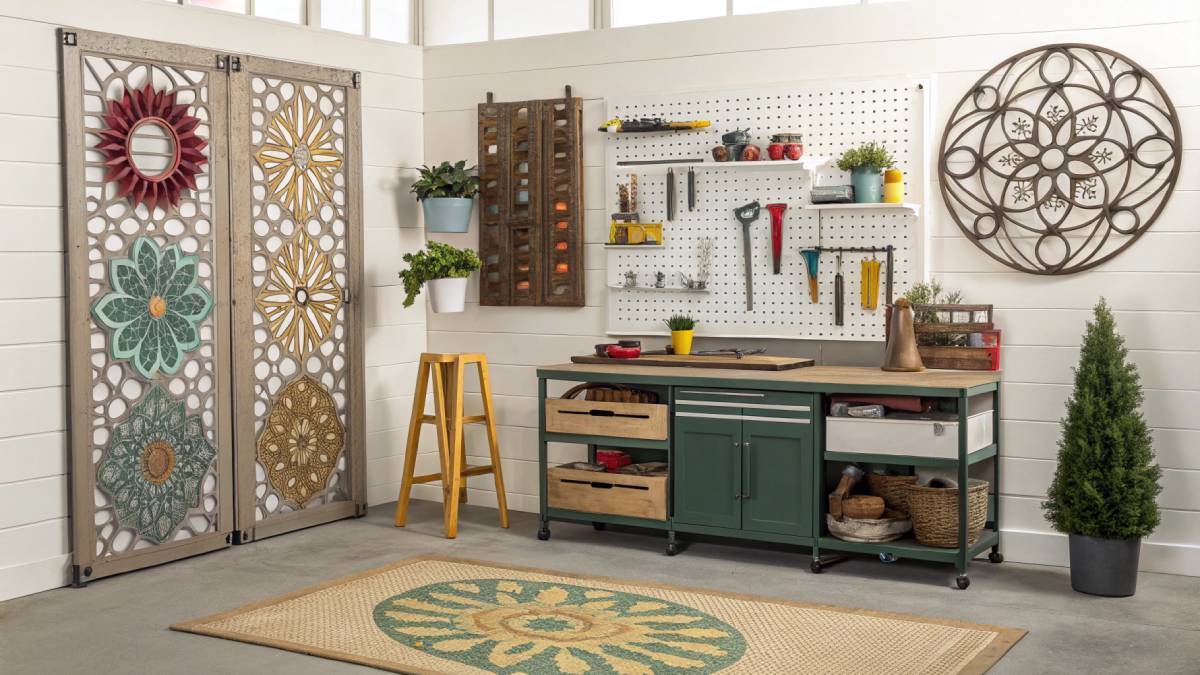When it comes to DIY projects, finding a material that combines versatility, durability, and aesthetic appeal can be a game-changer. Sheet metal stands out as a top contender, offering endless possibilities for both seasoned craftsmen and creative beginners alike.
Whether you’re looking to craft stunning home decor, build sturdy furniture, or create unique garden accessories, sheet metal provides the perfect foundation for your imaginative endeavors.
Why Choose Sheet Metal for Your DIY Projects?
Sheet metal has long been a favorite among DIY enthusiasts for good reason. Its robustness and flexibility make it ideal for a wide range of applications, from intricate sculptures to functional storage solutions. Unlike wood or plastic, sheet metal is resistant to wear and tear, ensuring that your creations not only look great but also stand the test of time.
Additionally, sheet metal’s ability to be easily cut, shaped, and welded allows for precise customization, enabling you to bring your most ambitious ideas to life with ease.
In this article, we’ll explore creative ways to use sheet metal for DIY projects, guiding you through everything from selecting the right type of metal to mastering essential techniques.
Whether you’re aiming to enhance your home with personalized decorations, build custom furniture pieces, or embark on innovative upcycling projects, you’ll find valuable insights and practical tips to fuel your creativity.
Get ready to discover how sheet metal can transform your DIY endeavors, offering both functionality and artistic expression in every project you undertake.
Understanding Sheet Metal Basics
Before diving into creative DIY projects, it’s essential to grasp the fundamentals of sheet metal. Understanding the different types, their properties, and the necessary tools will set you up for success in your metalworking endeavors.
Types of Sheet Metal
Sheet metal comes in various types, each with unique characteristics that make them suitable for different projects. Here are the most common types used in DIY projects:
1. Aluminum
Aluminum sheet metal is lightweight, highly malleable, and resistant to corrosion. Its ease of cutting and shaping makes it a favorite for intricate designs and decorative pieces. Additionally, aluminum’s reflective surface can add a sleek, modern touch to your projects.
2. Stainless Steel
Known for its strength and durability, stainless steel is ideal for projects that require resilience and a polished finish. It’s resistant to rust and stains, making it perfect for both indoor and outdoor applications. While harder to work with than aluminum, stainless steel offers a professional look and long-lasting performance.
3. Copper
Copper sheet metal boasts a rich, warm aesthetic that develops a beautiful patina over time. It’s highly malleable, allowing for detailed craftsmanship in jewelry, sculptures, and decorative items. Copper is also antimicrobial, making it suitable for kitchen accessories and other functional items.
4. Galvanized Steel
Galvanized steel is coated with a layer of zinc, providing excellent corrosion resistance. This type is robust and cost-effective, making it suitable for structural projects like fencing, gates, and outdoor fixtures. Its durability ensures that projects can withstand harsh weather conditions.
Essential Properties
Understanding the key properties of sheet metal is crucial for selecting the right material for your project.
1. Thickness and Gauge
Sheet metal thickness is measured in gauge, with a higher gauge number indicating thinner metal. The choice of thickness depends on the project’s requirements:
- Lower Gauge (e.g., 16-20): Thicker and more durable, suitable for structural components and heavy-duty applications.
- Higher Gauge (e.g., 22-28): Thinner and more flexible, ideal for decorative items and intricate designs.
| Gauge | Thickness (inches) | Common Uses |
|---|---|---|
| 16 | 0.0599 | Furniture, structural parts |
| 18 | 0.0478 | Shelving, storage boxes |
| 22 | 0.0299 | Decorative items, light fixtures |
| 26 | 0.0149 | Jewelry, small accessories |
2. Flexibility and Strength
Different sheet metals offer varying levels of flexibility and strength. For instance, aluminum is highly flexible and easy to bend, making it suitable for detailed designs. In contrast, stainless steel provides exceptional strength, making it ideal for projects that require durability and stability.
Tools and Equipment Needed
Equipping yourself with the right tools is essential for effectively working with sheet metal. Here’s a list of essential tools and equipment:
1. Cutting Tools
- Shears and Tin Snips: Ideal for manual cutting of thin sheet metal.
- Laser Cutters: Provide precise and intricate cuts that are perfect for detailed designs.
- Jigsaw or Circular Saw: Useful for cutting thicker sheet metals with the appropriate blade.
2. Shaping Tools
- Benders: These are used to make precise bends and angles.
- Rollers: To create curves and cylindrical shapes.
- Hammer and Mallet: For manual shaping and forming.
3. Fastening Tools
- Welders: Essential for joining metal pieces permanently.
- Riveters: Useful for fastening without welding, ideal for projects requiring disassembly.
- Screws and Bolts: For secure and adjustable connections.
4. Safety Gear
- Gloves: Protect hands from sharp edges and hot surfaces.
- Safety Glasses: Shield eyes from debris and sparks.
- Protective Clothing: Prevents injuries from metal shards and provides overall protection.
Creative DIY Projects Using Sheet Metal
Sheet metal’s versatility opens up a world of creative possibilities for DIY enthusiasts. Here are some inspiring project ideas to get you started:
Home Decor Projects
1. Wall Art and Sculptures
Transform plain walls into stunning displays with sheet metal art. Whether it’s abstract designs, geometric patterns, or custom-made sculptures, sheet metal allows for intricate detailing and a modern aesthetic. These pieces can serve as focal points in any room, adding texture and visual interest.
2. Decorative Shelving Units
Create unique shelving units that combine functionality with artistic flair. Sheet metal shelves can be designed in various shapes and sizes, providing a sturdy yet stylish way to display books, plants, and decorative items. Incorporate different metal finishes to match your interior décor.
3. Metal Clocks
Craft a one-of-a-kind clock using sheet metal as the base. Customize the design with cut-out numbers, unique shapes, or artistic embellishments. The durability of sheet metal ensures that your clock will remain a striking feature in your home for years to come.
Furniture Making
1. Metal Tables and Chairs
Build durable and stylish furniture pieces like tables and chairs from sheet metal. Combining metal with other materials such as wood or glass can create a balanced and modern look. Sheet metal’s strength ensures that your furniture is both functional and long-lasting.
2. Custom Shelving Systems
Design and construct custom shelving systems tailored to your specific needs. Sheet metal shelves can be freestanding or wall-mounted, offering a sleek and industrial look. These shelves are perfect for displaying books, collectibles, or kitchenware.
3. Metal Planters and Stands
Elevate your indoor and outdoor gardening with metal planters and stands. Sheet metal’s resistance to weather makes it ideal for outdoor use, while its versatility allows for creative designs that complement your garden or home décor.
Functional Items
1. Custom Tool Racks
Organize your workspace with custom tool racks made from sheet metal. These racks can be designed to hold specific tools, ensuring everything is within easy reach. The durability of sheet metal makes it perfect for supporting heavy tools without bending or breaking.
2. Storage Boxes and Bins
Create sturdy storage solutions with sheet metal boxes and bins. These containers can be customized in size and shape to fit your storage needs, whether for the garage, workshop, or home. Sheet metal’s robust nature ensures your items are well-protected.
3. Kitchen Accessories (Pot Racks, Utensil Holders)
Enhance your kitchen with functional and stylish accessories made from sheet metal. Pot racks can be suspended from the ceiling, saving cabinet space, while utensil holders keep your tools organized and within reach. The sleek look of metal adds a modern touch to your kitchen.
Garden and Outdoor Projects
1. Metal Garden Sculptures
Add artistic flair to your garden with metal sculptures. From abstract shapes to animal figures, sheet metal allows you to create eye-catching pieces that withstand outdoor conditions. These sculptures can serve as unique focal points in your garden landscape.
2. Decorative Fencing and Gates
Upgrade your garden’s perimeter with decorative fencing and gates made from sheet metal. Custom designs can enhance the aesthetic appeal while providing security and durability. Choose from various finishes to match your garden’s style.
3. Outdoor Lighting Fixtures
Illuminate your outdoor spaces with sheet metal lighting fixtures. Custom-designed lanterns, sconces, and pendant lights can add both functionality and ambiance to your garden, patio, or pathway. The versatility of sheet metal allows for creative lighting solutions that complement your outdoor décor.
E. Upcycling and Repurposing
1. Transforming Old Metal Parts into New Items
Give old metal parts a new lease on life by repurposing them into useful items. For example, old metal pipes can be converted into decorative frames or scrap metal pieces can be turned into unique shelving units. Upcycling reduces waste and adds a personal touch to your projects.
2. Creating Unique Jewelry and Accessories
Design and craft unique jewelry pieces like earrings, necklaces, and bracelets from sheet metal. Its malleability allows for intricate designs and personalized styles. Additionally, sheet metal accessories can be tailored to match your fashion preferences and make standout statements.
3. Repurposing Sheet Metal for Vehicle Mods
Enhance your vehicle’s appearance and functionality with sheet metal modifications. Custom grilles, bumpers, and other exterior parts can be crafted to give your vehicle a distinctive look. Sheet metal’s strength ensures that these modifications are both stylish and durable.
By understanding the basics of sheet metal and exploring these creative DIY projects, you can unlock the full potential of this versatile material. Whether you’re enhancing your home, crafting functional items, or upcycling old materials, sheet metal offers endless opportunities for creativity and innovation in your DIY endeavors.
Techniques for Working with Sheet Metal
Mastering the techniques for cutting, shaping, joining, and finishing sheet metal is crucial for successful DIY projects. Whether you’re a beginner or an experienced DIY enthusiast, understanding these methods will enhance the quality and durability of your creations.
Cutting and Shaping
1. Accurate Measuring and Marking
Precision starts with accurate measuring and marking. Use a metal ruler or a tape measure to ensure your dimensions are exact. Mark your cut lines clearly with a permanent marker or a scribe tool. For intricate designs, consider using a grid system to maintain symmetry and balance.
2. Cutting Techniques for Precision
Choosing the right cutting technique is essential for achieving clean and precise edges. Here are some popular methods:
- Shears and Tin Snips: Ideal for straight or slightly curved cuts on thin sheet metal. They are manual tools that offer control but can be labor-intensive for larger projects.
- Laser Cutters: Provide high precision and intricate detail, perfect for complex designs. While more expensive, laser cutters save time and reduce material waste.
- Jigsaws and Circular Saws: Suitable for cutting thicker sheet metal. Ensure you use the appropriate blade to avoid jagged edges and achieve smooth cuts.
3. Bending and Forming Methods
Shaping sheet metal requires the right tools and techniques to achieve the desired form without compromising the material’s integrity.
- Manual Benders: Perfect for small bends and angles. They offer control but may require significant effort for thicker metals.
- Power Rollers: Ideal for creating curves and cylindrical shapes. They provide consistent results and can handle thicker materials with ease.
- Hammer and Anvil: Traditional methods for shaping metal by hand. Useful for custom adjustments and adding texture to your projects.
Joining Sheet Metal
1. Welding Basics
Welding is a fundamental technique for joining sheet metal pieces permanently. Common welding methods include:
- MIG Welding (Metal Inert Gas): Easy to learn and versatile, suitable for most DIY projects involving aluminum and steel.
- TIG Welding (Tungsten Inert Gas): Offers greater precision and control, ideal for thinner metals and detailed work.
- Spot Welding: Best for joining overlapping sheets without the need for filler material.
2. Riveting and Screwing
For projects that may require disassembly or added flexibility, riveting and screwing are excellent alternatives to welding.
- Riveting: Provides strong, permanent joints without the need for heat. Ideal for decorative projects where welding marks might be undesirable.
- Screwing: Allows for adjustable and removable connections. Use sheet metal screws for secure fastening.
3. Adhesive Solutions
Adhesives can be used to bond sheet metal pieces, especially when welding or mechanical fasteners are not feasible.
- Epoxy Adhesives: Offer strong bonds and are suitable for various metals. They provide flexibility and resistance to environmental factors.
- Silicone Adhesives: Ideal for applications requiring flexibility and water resistance, such as outdoor projects.
Finishing Touches
1. Sanding and Smoothing Edges
After cutting and shaping, it’s essential to smooth out any rough edges to prevent injuries and enhance the appearance of your project.
- Sandpaper and Files: Use progressively finer grits to achieve a smooth finish.
- Deburring Tools: Remove sharp edges and burrs quickly and efficiently.
2. Painting and Coating for Aesthetics and Protection
Finishing your sheet metal projects with paint or coatings not only improves their appearance but also protects them from corrosion and wear.
- Priming: Apply a metal primer to ensure better paint adhesion and prevent rust.
- Spray Paints: Provide a smooth and even finish, available in a wide range of colors.
- Powder Coating: Offers a durable and high-quality finish, ideal for outdoor and high-wear applications.
3. Applying Decorative Elements
Enhance your sheet metal projects with decorative touches to add personality and style.
- Stenciling and Etching: Create intricate patterns and designs for a customized look.
- Embellishments: Add beads, rivets, or other decorative hardware to elevate the overall design.
Safety Tips When Working with Sheet Metal
Working with sheet metal can be rewarding, but it’s essential to prioritize safety to prevent accidents and injuries. Here are key safety tips to keep in mind during your DIY projects.
Personal Protective Equipment (PPE)
1. Gloves
Wear durable gloves to protect your hands from sharp edges, hot surfaces, and metal shards. Choose gloves that offer both flexibility and grip for better handling of tools and materials.
2. Safety Glasses
Protect your eyes from flying debris, sparks, and metal fragments by wearing safety glasses or goggles. Ensure they fit securely and provide clear visibility.
3. Protective Clothing
Wear long sleeves and sturdy clothing to shield your skin from cuts and abrasions. Consider using aprons or coveralls when performing tasks that involve welding or grinding.
Safe Handling Practices
1. Proper Lifting Techniques
Sheet metal can be heavy and unwieldy. Use proper lifting techniques to avoid back injuries:
- Bend at the knees, not the waist.
- Lift with your legs, keeping the sheet metal close to your body.
- Use mechanical aids like dollies or lifting straps for larger pieces.
2. Managing Sharp Edges
After cutting and shaping, sheet metal edges can be extremely sharp. Always handle with care:
- Use edge guards or tape to cover sharp edges.
- Store sheet metal flat to prevent bending and accidental cuts.
Tool Safety
1. Operating Cutting and Shaping Tools Safely
Each tool has specific safety guidelines to follow:
- Shears and Tin Snips: Keep fingers clear of cutting paths and use both hands for better control.
- Laser Cutters: Ensure proper ventilation and follow manufacturer instructions to prevent burns or fires.
- Welders: Maintain a safe distance from the welding arc and use appropriate shielding to protect against UV radiation.
2. Ventilation When Welding or Painting
Many sheet metal finishing processes produce fumes and airborne particles. Ensure adequate ventilation to maintain air quality:
- Welding: Work in well-ventilated areas or use fume extractors to minimize inhalation of harmful fumes.
- Painting: Use spray paints in open spaces or with exhaust fans to disperse fumes. Wear a respirator if necessary.
Safety Checklist Table
| Safety Aspect | Recommendations |
|---|---|
| PPE | Wear gloves, safety glasses, and protective clothing. |
| Tool Handling | Follow manufacturer guidelines and use tools properly. |
| Workspace Safety | Keep your workspace clean and free of clutter. |
| Fire Safety | Keep a fire extinguisher nearby when welding or cutting. |
| First Aid | Have a first aid kit accessible in case of accidents. |
By mastering these techniques and adhering to safety practices, you can confidently tackle a wide range of sheet metal DIY projects. Whether you’re creating stunning home decor, functional furniture, or unique garden accessories, understanding the basics of working with sheet metal will help you achieve professional-quality results.
Always prioritize safety, invest in the right tools, and let your creativity guide you to transform sheet metal into beautiful and durable creations.
Tips for Successful Sheet Metal DIY Projects
Embarking on a sheet metal DIY project can be both exciting and challenging. To ensure your projects are successful and enjoyable, it’s essential to follow some key tips that cover planning, budgeting, and skill development. Here’s how to set yourself up for success in your sheet metal endeavors.
Planning and Design
1. Sketching Your Ideas
Every successful DIY project begins with a solid plan. Start by sketching your ideas on paper or using digital design software. This helps you visualize the final product and identify any potential challenges early on. Detailed sketches allow you to experiment with different designs and make adjustments before cutting any metal.
Pro Tip: Use graph paper or design templates to maintain scale and proportion in your sketches. This ensures accuracy when you transition from design to actual construction.
2. Measuring Accurately
Precision is crucial when working with sheet metal. Accurate measurements prevent material wastage and ensure that all parts fit together seamlessly. Use reliable measuring tools such as metal rulers, calipers, and measuring tapes. Double-check your measurements before making any cuts or bends.
Measurement Checklist:
- Confirm the dimensions on your sketch.
- Measure the sheet metal twice before cutting.
- Mark cut lines clearly using a permanent marker or scribe tool.
3. Selecting the Right Type of Sheet Metal
Choosing the appropriate type of sheet metal is vital for the success of your project. Consider factors such as strength, flexibility, and aesthetic appeal when selecting your material. Refer to the Types of Sheet Metal section to understand which metal best suits your project’s requirements.
Sheet Metal Selection Table:
| Project Type | Recommended Sheet Metal | Reason |
|---|---|---|
| Decorative Sculptures | Aluminum or Copper | Malleable and easy to shape with aesthetic appeal |
| Outdoor Furniture | Galvanized Steel | Resistant to rust and weather conditions |
| Functional Storage Units | Stainless Steel | Durable and strong for heavy-duty use |
| Jewelry and Small Accessories | Copper or Thin Aluminum | Highly flexible for intricate designs |
Budgeting and Sourcing Materials
1. Cost-Effective Material Sourcing
Managing your budget effectively can make a significant difference in your DIY projects. Here are some strategies to source sheet metal affordably:
- Local Scrap Yards: Purchase recycled sheet metal at a fraction of the cost of new materials.
- Online Marketplaces: Websites like eBay or Craigslist often have deals on sheet metal in various sizes and types.
- Bulk Purchasing: If you have multiple projects, buying in bulk can reduce the cost per unit.
Cost Comparison Table:
| Source | Cost per Square Foot | Pros | Cons |
|---|---|---|---|
| Local Scrap Yards | $1.50 – $3.00 | Affordable, eco-friendly | Limited selection |
| Online Marketplaces | $2.00 – $4.50 | Wide variety, convenient | Shipping costs may apply |
| Bulk Suppliers | $1.00 – $2.50 | Lower cost per unit, reliable supply | Requires upfront investment |
2. Reusing and Recycling Materials
Upcycling old sheet metal not only saves money but also contributes to environmental sustainability. Repurpose scrap metal from household items, old appliances, or discarded furniture. Transforming existing materials into new projects adds a unique touch and reduces waste.
Upcycling Ideas:
- Convert old metal doors into decorative wall art.
- Use scrap metal pieces to create custom tool racks or storage solutions.
- Repurpose metal pipes into garden planters or outdoor lighting fixtures.
Learning and Improving Skills
1. Tutorials and Online Resources
Continuous learning is key to mastering sheet metal projects. Leverage the wealth of tutorials and online resources available to enhance your skills.
- YouTube Channels: Follow channels dedicated to metalworking and DIY projects for step-by-step guidance.
- Online Courses: Enroll in courses on platforms like Udemy or Skillshare to learn advanced techniques.
- Blogs and Forums: Join DIY and metalworking communities to exchange ideas and seek advice.
Recommended Resources Table:
| Resource Type | Example | Benefit |
|---|---|---|
| YouTube Channels | “This Old Tony,” “Jimmy Diresta” | Visual demonstrations and tips |
| Online Courses | Udemy’s “Metalworking Basics” | Structured learning paths |
| Blogs and Forums | Reddit’s r/Metalworking, Instructables | Community support and project ideas |
2. Practice Projects to Enhance Techniques
Start with simple projects to build your confidence and refine your techniques. Practice cutting, bending, and joining sheet metal before tackling more complex endeavors. Each project will help you understand the material’s properties and improve your craftsmanship.
Beginner Practice Projects:
- Simple metal trays or boxes.
- Basic wall hooks or key holders.
- Small decorative sculptures or candle holders.
Intermediate Projects:
- Custom shelving units or tool racks.
- Metal planters with intricate designs.
- Functional furniture pieces like tables or chairs.
Inspiring Examples and Case Studies
Drawing inspiration from successful DIY projects can spark creativity and provide practical insights. Here are some inspiring examples and real-life case studies to motivate your sheet metal endeavors.
Showcase of Successful DIY Projects
1. Detailed Project Walkthroughs
Explore detailed walkthroughs of successful sheet metal projects to understand the process from start to finish. These case studies highlight the steps involved, the materials used, and the challenges overcome.
Example Project: Metal Wall Art
- Objective: Create a geometric metal wall art piece.
- Materials: 16-gauge galvanized steel, metal shears, rivet gun, spray paint.
- Steps:
- Sketch the geometric design.
- Measure and mark the steel sheet accordingly.
- Cut the shapes using metal shears.
- Assemble the pieces using rivets.
- Sand and smooth the edges.
- Paint with a metallic finish.
- Outcome: A stunning, modern wall art piece that adds depth and texture to any room.
2. Before and After Transformations
Before and after photos can vividly illustrate the impact of sheet metal projects. These transformations showcase the potential of sheet metal to turn ordinary spaces or items into extraordinary creations.
Transformation Example: From Old Grill to Garden Planter
- Before: An old, rusted grill discarded in the backyard.
- After: Cleaned and repurposed into a stylish garden planter with added drainage holes and a protective paint finish.
- Impact: The old grill becomes a functional and decorative element in the garden, reducing waste and adding charm.
Interviews with DIY Enthusiasts
Gaining insights from experienced DIY enthusiasts can provide valuable tips and inspiration. Here are some highlights from interviews with sheet metal project experts.
1. Personal Experiences
DIY enthusiasts share their journeys, including the challenges they faced and the solutions they found. These personal stories highlight the learning curve and the satisfaction of completing a successful project.
Interview Highlight: “I started with simple metal shelves, and as I gained confidence, I moved on to more complex furniture pieces. The key was patience and continuous practice. Each project taught me something new about handling and shaping sheet metal.” – Jane Doe, DIY Blogger
2. Tips and Tricks from Experts
Experts offer practical advice that can help you avoid common mistakes and enhance your projects’ quality. Their tips are based on years of experience and can significantly improve your metalworking skills.
Expert Tips:
- Anne Smith, Metal Artist: “Always wear protective gear, even for small projects. Safety should never be compromised.”
- John Lee, DIY Enthusiast: “Invest in good quality tools. They make the process smoother and the results more professional.”
- Maria Gonzalez, Upcycling Specialist: “Don’t be afraid to experiment with different finishes. Powder coating can completely transform the look of your metal pieces.”
By incorporating these tips and drawing inspiration from real-life examples, your sheet metal DIY projects are sure to be successful and fulfilling.
Whether you’re planning a small home decor item or a large outdoor structure, thoughtful preparation, smart budgeting, and continuous skill improvement will help you create stunning and durable sheet metal creations.
Conclusion
Throughout this article, we’ve explored the versatility of sheet metal in a variety of DIY projects. From home decor items like wall art and metal clocks to functional pieces such as tool racks and storage bins, sheet metal proves to be an invaluable material for creative enthusiasts.
We’ve also delved into furniture making, highlighting how metal tables, chairs, and planters can add a modern and industrial flair to any space.
Additionally, garden and outdoor projects showcase sheet metal’s durability and aesthetic appeal, making it perfect for sculptures, fencing, and lighting fixtures. Finally, the upcycling and repurposing section emphasized the environmental and creative benefits of transforming old metal parts into new, unique items.
The beauty of sheet metal lies in its adaptability and the endless possibilities it offers. Whether you’re a seasoned DIYer or just starting out, there’s always something new to create with sheet metal. Don’t hesitate to experiment with different types, finishes, and techniques to discover what works best for your projects.
Embrace the learning curve, and remember that each project is an opportunity to hone your skills and unleash your creativity.
By pushing the boundaries of what’s possible with sheet metal, you can develop truly unique and personalized creations that reflect your individual style and ingenuity.
Final Thoughts on the Benefits of Sheet Metal in DIY Projects
Sheet metal stands out as a superior material for DIY projects due to its durability, aesthetic versatility, and ease of customization. Its ability to be cut, shaped, and joined in numerous ways makes it suitable for a wide range of applications, from practical storage solutions to intricate decorative pieces.
Additionally, working with sheet metal encourages sustainable practices through upcycling and repurposing, contributing to environmental conservation.
By choosing sheet metal for your DIY endeavors, you not only create long-lasting and visually appealing items but also embrace a material that offers both functionality and artistic expression.
Additional Resources
To help you embark on your sheet metal DIY journey, we’ve compiled a list of recommended tools and suppliers, tutorials and guides for beginners, and community forums and support groups. These resources will provide you with the knowledge, materials, and support needed to create stunning sheet metal projects.
Recommended Tools and Suppliers
Having the right tools and sourcing quality materials are crucial for successful sheet metal projects. Below is a table of essential tools along with recommended suppliers to help you get started:
| Tool Category | Essential Tools | Recommended Suppliers | Price Range |
|---|---|---|---|
| Cutting Tools | Shears, Tin Snips, Laser Cutters | Home Depot, Amazon, Laser Cutting Services | $20 – $500 |
| Shaping Tools | Benders, Rollers, Hammer and Mallet | Harbor Freight, Grainger | $15 – $150 |
| Fastening Tools | Welders (MIG/TIG), Riveters, Screwdrivers | Lincoln Electric, Amazon, Lowe’s | $100 – $600 |
| Safety Gear | Gloves, Safety Glasses, Protective Clothing | 3M, Home Depot, Amazon | $10 – $100 |
| Measuring Tools | Metal Rulers, Calipers, Measuring Tapes | Mitutoyo, Amazon, Home Depot | $10 – $50 |
| Finishing Tools | Sandpaper, Files, Paint Sprayers | Home Depot, Amazon, Grizzly Tools | $5 – $200 |
Top Suppliers:
- Home Depot: Offers a wide range of sheet metal tools and materials, both in-store and online.
- Amazon: Provides a vast selection of tools with customer reviews to help you choose the best options.
- Lincoln Electric: Specializes in welding equipment and supplies, ideal for serious DIYers and professionals.
- Harbor Freight: Known for affordable tools that are perfect for beginners and budget-conscious projects.
- Grainger: Supplies high-quality industrial tools and materials for more advanced sheet metal work.
Tutorials and Guides for Beginners
Learning the basics and advancing your skills is essential for successful sheet metal projects. Here are some valuable tutorials and guides to help you get started:
| Resource Type | Example | Description | Access |
|---|---|---|---|
| YouTube Channels | This Old Tony, Jimmy Diresta | Step-by-step video tutorials on various sheet metal projects and techniques. | This Old Tony Jimmy Diresta |
| Online Courses | Udemy’s “Metalworking Basics,” Skillshare’s “Intro to Sheet Metal Crafting” | Comprehensive courses covering fundamental to advanced sheet metal techniques. | Udemy Skillshare |
| Blogs and Websites | Instructables, Metalworking News | Detailed guides, project ideas, and tips from experienced DIYers and metalworkers. | Instructables Metalworking News |
| Books | “Sheet Metal Handbook” by Ron Fournier, “The Metalworker’s Bedside Reader” by Mike Zappalorti | In-depth knowledge of sheet metal techniques, tools, and project ideas. | Available on Amazon, local bookstores |
Community Forums and Support Groups
Joining communities and forums can provide you with support, inspiration, and solutions to challenges you may encounter. Here are some popular platforms to connect with fellow sheet metal enthusiasts:
| Community Type | Platform | Description | Link |
|---|---|---|---|
| Forums | Reddit’s r/Metalworking, WeldingWeb | Active discussions on techniques, projects, and tool recommendations. | r/Metalworking WeldingWeb |
| Facebook Groups | Sheet Metal DIY Projects, Metal Artistry | Groups where members share their projects, seek advice and collaborate. | Search on Facebook for relevant groups |
| Online Communities | Instructables Community, The Fabricator’s Forum | Platforms for sharing tutorials, showcasing projects, and networking with other metalworkers. | Instructables The Fabricator |
| Local Workshops and Meetups | Meetup.com, Local Maker Spaces | Opportunities to join hands-on workshops, meet like-minded individuals and learn from experts in person. | Meetup |
Benefits of Joining Communities:
- Inspiration: Discover new project ideas and creative techniques.
- Support: Get answers to your questions and troubleshoot issues with the help of experienced members.
- Networking: Connect with other DIY enthusiasts and professionals in the sheet metal industry.
- Resources: Access shared tools, materials, and collaborative projects that can enhance your skills and expand your toolkit.
By leveraging these additional resources, you can enhance your sheet metal DIY projects with the right tools, knowledge, and community support. Whether you’re sourcing materials, seeking tutorials, or connecting with fellow enthusiasts, these resources will empower you to create stunning and durable sheet metal creations with confidence.
FAQs
What types of sheet metal are best for DIY projects?
Different projects require different types of sheet metal. Aluminum is lightweight and easy to shape, making it ideal for decorative pieces. Stainless steel offers strength and durability, perfect for functional items like tool racks.
Copper provides a rich aesthetic for jewelry and small accessories, while galvanized steel is excellent for outdoor projects due to its corrosion resistance.
How do I safely handle and work with sheet metal?
Safety is paramount when working with sheet metal. Always wear personal protective equipment (PPE) such as gloves, safety glasses, and protective clothing.
Use proper lifting techniques to handle heavy sheets and manage sharp edges by sanding or using edge guards. Additionally, ensure proper tool safety by following manufacturer guidelines and maintaining a clean workspace.
What tools are essential for sheet metal DIY projects?
Essential tools include cutting tools like shears and laser cutters, shaping tools such as benders and rollers, and fastening tools like welders and riveters.
Measuring tools like metal rulers and calipers are crucial for precision. Don’t forget to use sanding and finishing tools to smooth edges and apply coatings for a professional finish.
Can I reuse and recycle sheet metal for my projects?
Absolutely! Reusing and recycling sheet metal is both cost-effective and environmentally friendly. You can repurpose old metal parts from household items, appliances, or discarded furniture. Upcycling not only reduces waste but also adds a unique, personalized touch to your DIY projects.
Where can I find tutorials and resources for sheet metal projects?
There are numerous tutorials and online resources available to help you master sheet metal projects.
Platforms like YouTube offer channels dedicated to metalworking, while websites like Instructables provide step-by-step guides. Additionally, online courses on platforms like Udemy and Skillshare can help you learn advanced techniques.
Final Thoughts
Embarking on sheet metal DIY projects offers a blend of creativity, functionality, and sustainability.
By understanding the basics, utilizing the right tools, and following essential safety practices, you can transform sheet metal into stunning and durable creations that enhance your home and lifestyle. Don’t be afraid to experiment and push the boundaries of your craftsmanship—every project is an opportunity to learn and grow.
Embrace the versatility of sheet metal and let your imagination take flight, creating unique pieces that reflect your personal style and ingenuity.
Main Tips Around the Article
- Plan Thoroughly: Start with detailed sketches and accurate measurements to ensure your project’s success.
- Choose the Right Metal: Select the appropriate type of sheet metal based on your project’s requirements for strength, flexibility, and aesthetics.
- Invest in Quality Tools: High-quality tools can make your projects easier and yield more professional results.
- Prioritize Safety: Always wear PPE and follow safe handling practices to prevent accidents.
- Start Small: Begin with simple projects to build your skills before tackling more complex designs.
- Reuse and Recycle: Upcycle old sheet metal to save costs and contribute to environmental sustainability.
- Continuous Learning: Utilize tutorials, online courses, and community forums to enhance your knowledge and skills.
Comprehensive List of Recommended Products and Accessories
Cutting Tools
- Metal Shears: Carter Steel Shears
- Tin Snips: Chadwick Manufacturing Tin Snips
- Laser Cutters: Glowforge Plus Laser Cutter
- Jigsaws with Metal Blades: Bosch 12855JGS Jig Saw
Shaping Tools
- Sheet Metal Benders: Irwin Tools Bending Brake
- Metal Rollers: Kreg R3 Metal Roller
- Hammer and Mallet: Vaughan Deluxe Hammer Set
Fastening Tools
- MIG Welders: Lincoln Electric K2185-1 Handy MIG Welder
- TIG Welders: AHP AlphaTIG 200X TIG Welder
- Riveters: Milwaukee Fastening Tools Riveter
- Sheet Metal Screws: Hillman Sheet Metal Screws
Safety Gear
- Gloves: Mechanix Wear Gloves
- Safety Glasses: 3M Virtua Safety Glasses
- Protective Clothing: DuPont Protective Coveralls
Measuring Tools
- Metal Rulers: Mitutoyo Stainless Steel Ruler
- Calipers: Mitutoyo Digital Caliper
- Measuring Tapes: Stanley FatMax Measuring Tape
Finishing Tools
- Sandpaper: 3M Sanding Sheets
- Files: Bahco Metalworking Files
- Paint Sprayers: Wagner SprayTech Paint Sprayer
- Powder Coating Kits: Eastwood Powder Coating Kit
Adhesives and Primers
- Epoxy Adhesives: J-B Weld Original Epoxy
- Metal Primers: Rust-Oleum Self Etching Primer
- Spray Paints: Krylon Fusion All-In-One Spray Paint
Additional Accessories
- Deburring Tools: Xuron Deburring Tool
- Edge Guards: 3M Edge Protection Tape
- Respirators: 3M Half Face Respirator
By equipping yourself with these recommended products and accessories, you’ll be well-prepared to tackle a wide range of sheet metal DIY projects with confidence and professionalism.




















